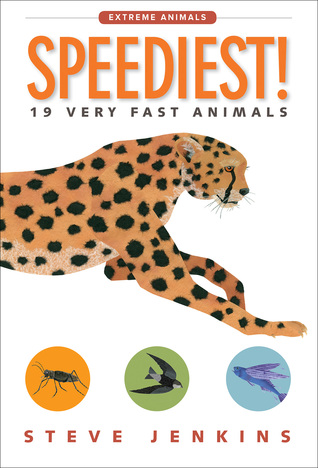WILD & WONDERFUL WEDNESDAY: Speediest!/How They Choked/Life on Surtsey
ABOUT THE BOOK
Caldecott Honor winner Steve Jenkins is back with more Extreme Animals, perfect for young readers looking for accessible nonfiction chock full of incredible art. Speediest! will focus on the fastest members of the animal kingdom.
Through illustrations, infographics, facts, and figures, readers will see how big each animal is compared to humans, where it lives on the globe, and just how quickly it can move!
With his signature art style, Steve Jenkins' Extreme Animals reader series explores nature's truly superlative animals. These readers are fact-packed and span the globe, detailing the astounding abilities of every shape, size, and species. Each installment focuses on amazing and unusual animals, making these nonfiction readers accessible, informative, and fascinating.
REVIEW
As in his other books, Speediest combines interesting animal factoids with gorgeous cut paper illustrations. This book focuses specifically on the fastest animals in the world. Animals that are highlighted include cheetahs, ostriches, brown hares, the road runner, and the falcon. The size of the book makes it particularly appealing to children in grades 1st through 3rd. In addition to each two page spread, Jenkins includes a glossary, bibliography, and graphs comparing the different animals. A great addition to a fun series that is sure to be popular with young animal lovers.
ABOUT THE BOOK
Over the course of history, famous people made mistakes that were so monumental they could never escape them, no matter how brilliant their successes! Ferdinand Magellan is credited as the first man to sail around the world . . . but he only actually made it halfway. His terrible treatment of everyone he met cut his life journey short. Queen Isabella of Spain is remembered for financing Columbus’s expeditions—and for creating the Spanish Inquisition. J. Bruce Ismay commissioned the unsinkable marvel of the sea, the Titanic—and then jumped the line of women and children to escape death on a lifeboat. Readers will be fascinated well past the final curtain and will empathize with the flawed humanity of these achievers.
Famous successful “failures” include:
Marco Polo • Queen Isabella of Spain • King Montezuma II • Anne Boleyn • Ferdinand Magellan • Isaac Newton • Benedict Arnold • George Armstrong Custer • Vincent Van Gogh • Susan B. Anthony • Thomas Alva Edison • J. Bruce Ismay • Amelia M. Earhart • Joseph Jefferson Jackson (“Shoeless Joe”)
REVIEW
The snarky tone of this book is bound to make it interesting to young adult readers. So often history books don't provide details about the people they mention, depriving young learners of the depth needed to truly start to understand historical events and people. Books like this one provide a look at people who left their mark on the world, bringing about change of various kinds, but they didn't necessarily do it in good ways. Whether one is talking about Queen Isabella of Spain who proved that women were capable of ruling a country, but who tortured many of her own people or George Armstrong Custer who became a general because of his daring, but who pridefully led his men to their deaths, Bragg focuses on famous individuals who succeeded in some things but failed utterly in others. A fascinating account of just how human our predecessors were.
On November 14, 1963, a volcano fifteen miles off the shore of Iceland exploded under the sea, resulting in a brand-new island. Scientists immediately recognized Surtsey for what it was: an opportunity to observe the way life takes hold.
Loree Griffin Burns follows entomologist Erling Ólafsson on a five-day trip to Surtsey, where since 1970 he has studied the arrival and survival of insects and other species. Readers see how demanding conditions on Surtsey can be, what it’s like to eat and work while making the smallest impact possible, and the passion driving these remarkable scientists in one of the world’s most unique fields ever!
REVIEW
One of the things I love about the Scientists in the Field series is the chance to visit other places vicariously. I'm not much of an adventurer myself, but reading these books makes me appreciate those who are. In this book, Burns gives the reader a glimpse into the study of a newly born island, created through volcanic activity. The author follows a group of scientists to the island where they spend a week gathering information about the plants and animals taking root on the island. The author provides an close-up look at the work of the scientists as well as a glimpse into Icelandic culture and the conditions that field scientists live with as they work in the field. It's always fascinating to me to read about the information gathered by field scientists as well as the methods used. Burns focuses on the work of Erling Olafsson, an entomologist, who has been studying the insects on the island for over thirty years. For young readers who enjoy science this series opens windows into fascinating worlds and the work people do to understand those worlds better.






Comments
Post a Comment